It is an interesting milestone when adapting to a new home country, when one starts revisiting favorite locations more often than one discovers new ones.
The beauty of Sri Lanka, of course, is that there is so much to discover on a relatively small island that, with minimum travel effort, can be explored repeatedly before retracing one’s footsteps, or before being satiated.
And so it is with Fort Galle, the gorgeous fortified town that became our architectural inspiration, when we ultimately decided to make Sri Lanka our principal base during the Asian leg of our Green Global Trek.
We live a mere 20 minutes by scooter or tuk tuk, and yet we don’t come to Galle as frequently as I’d like to. Every trip for me (Ben) is a visual treat. I love the majestic white buildings in narrow alleys that all eventually end against the wind-swept ramparts. I welcome the languid pace of life. During low season, that is. When waves of tourists swell the city at the height of the tourist seasons, then the charm is lost in the brouhaha. But now in May we are blessed by the tranquility of the low season.
Thus it is time to enjoy a stroll in Galle. We are anything but blase about Galle. Hopefully, we will never tire of strolling these streets.
On our way to Fort Galle, we stop to enjoy the coastal views.
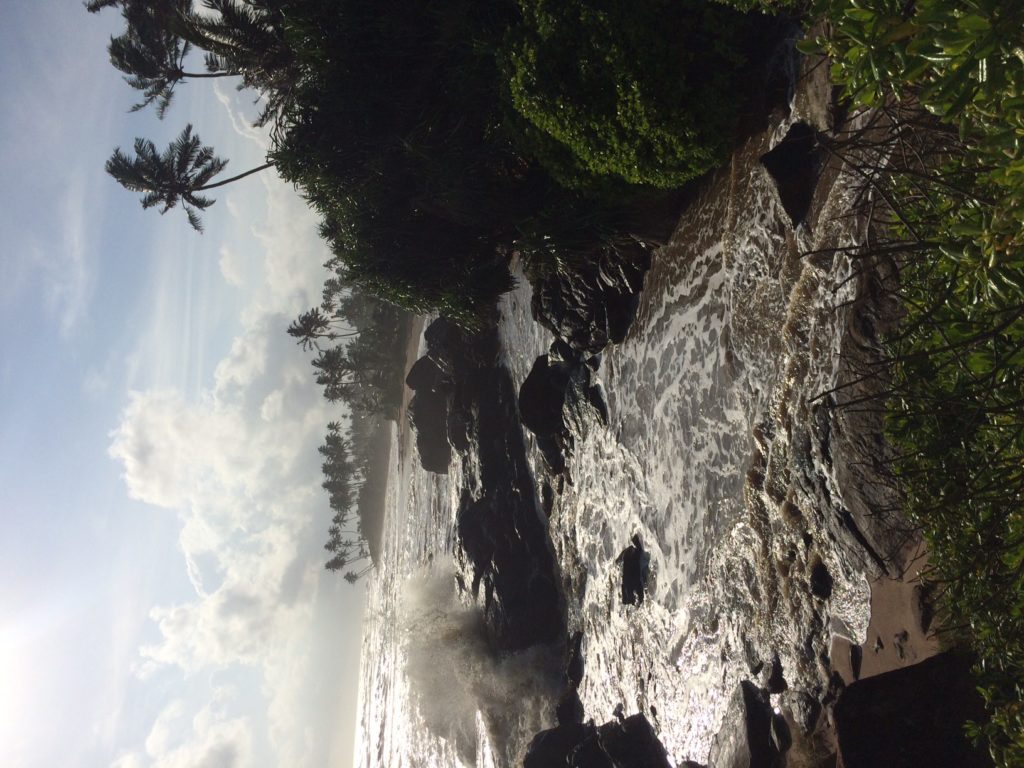
Classic Sri Lankan coast.. palm trees soaring, blue skies, rocks and surf.
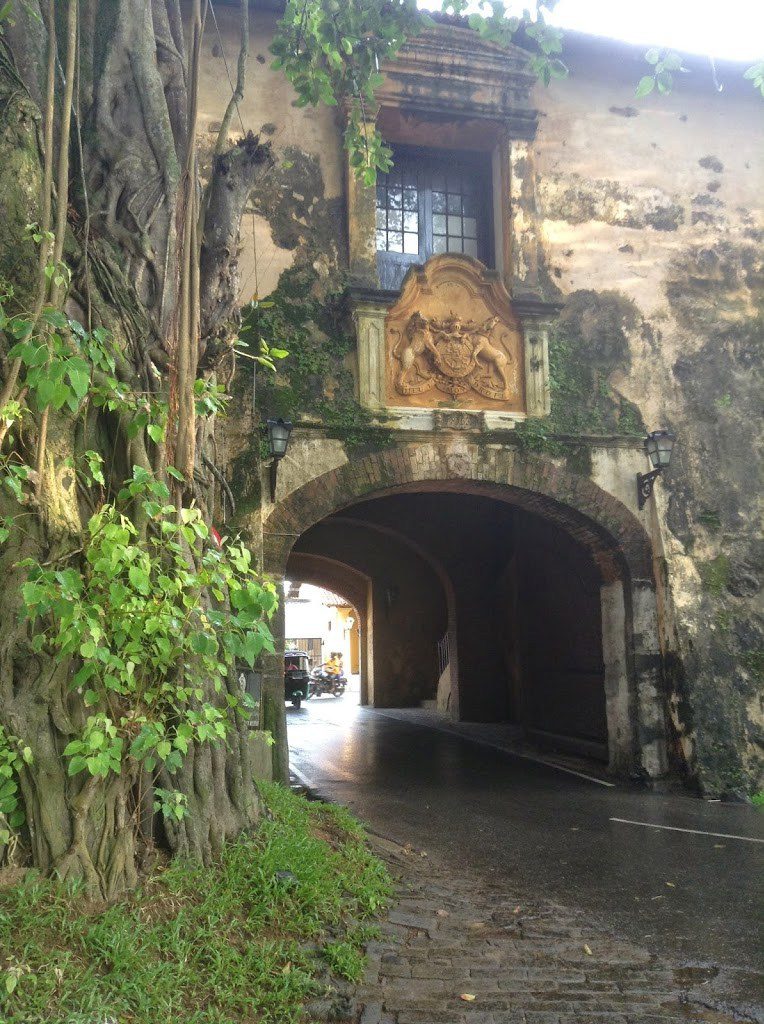
One of the entrances into Fort Galle.
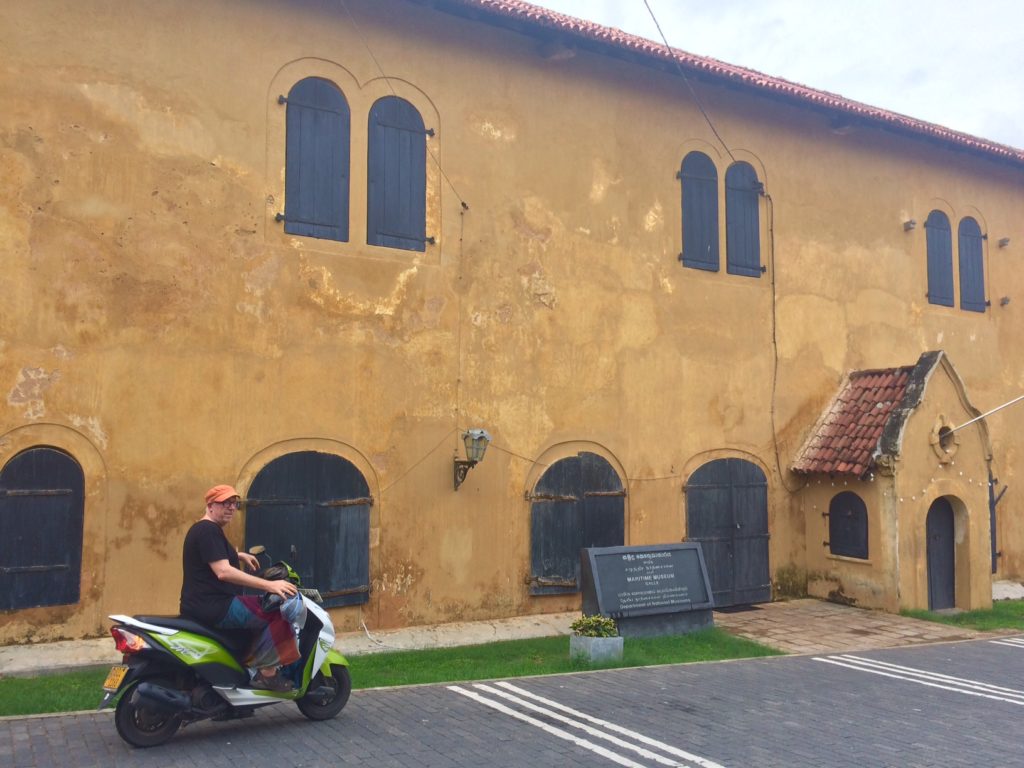
This gorgeous building houses the Maritime museum. We have visited it before and it is chockfull of maritime treasures and a window into the lives of Galle residents many generations ago. The ochre colored walls, on such a large building, stand in stark contrast with the rest of the town, which is mostly white.
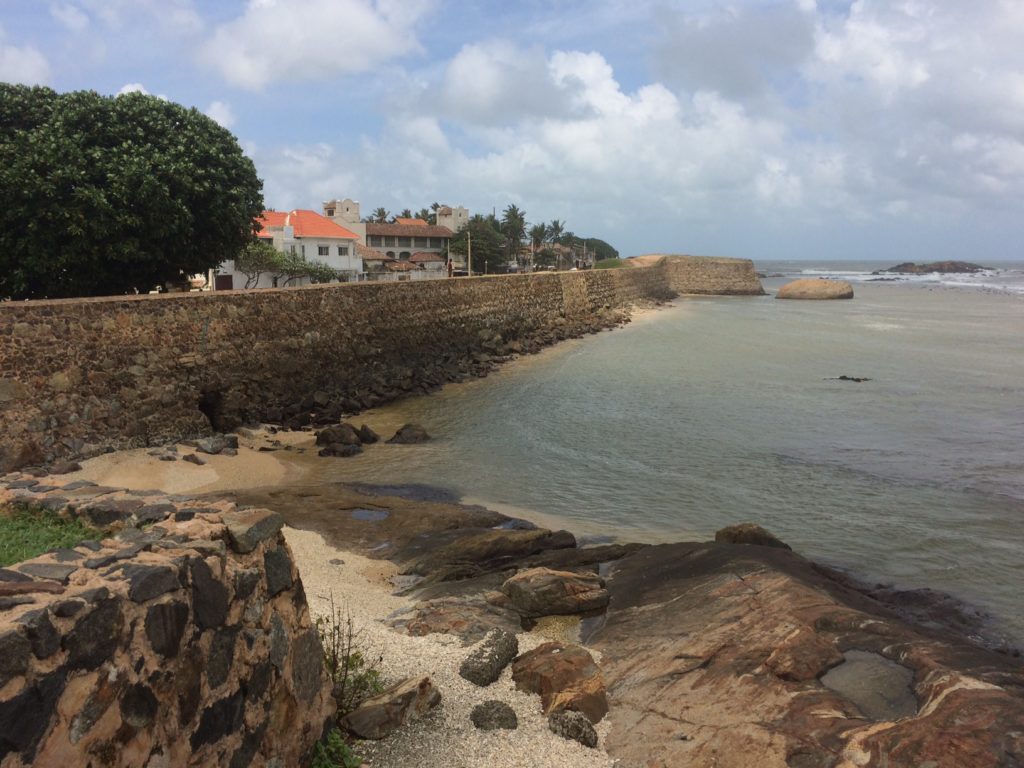
One of our favorite views from the ramparts looking back towards the city.
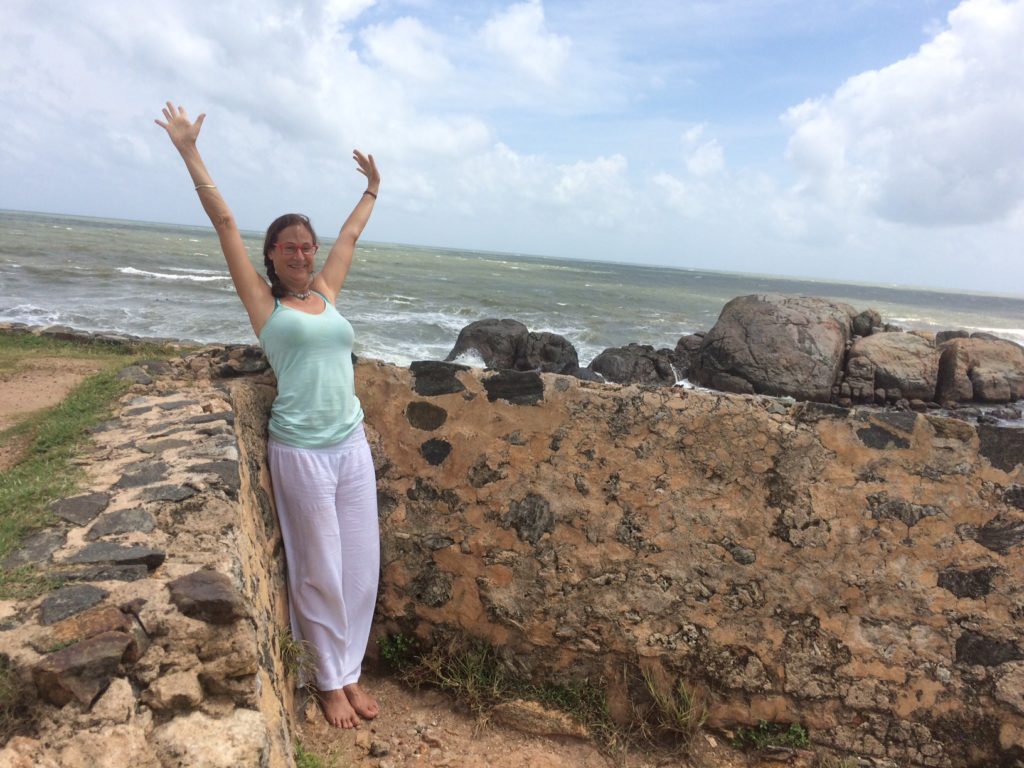
It has stopped raining and the weather is great.. sunny and windy and warm.
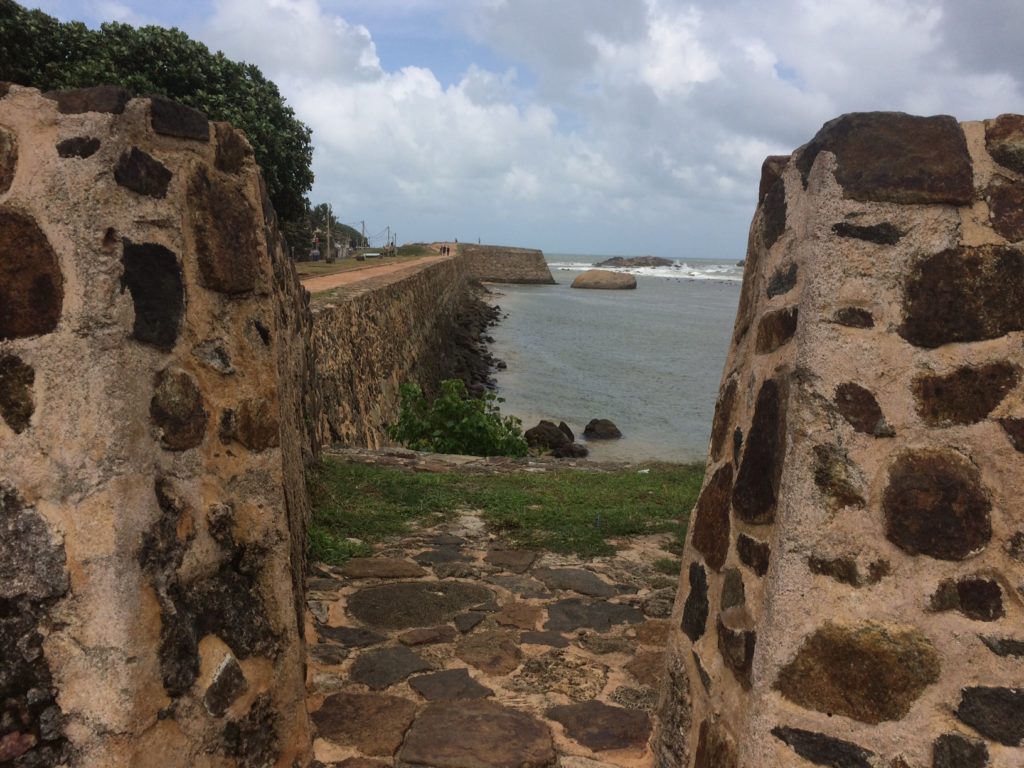
One really only appreciates how very thick the walls of the ramparts are when one is standing right there.
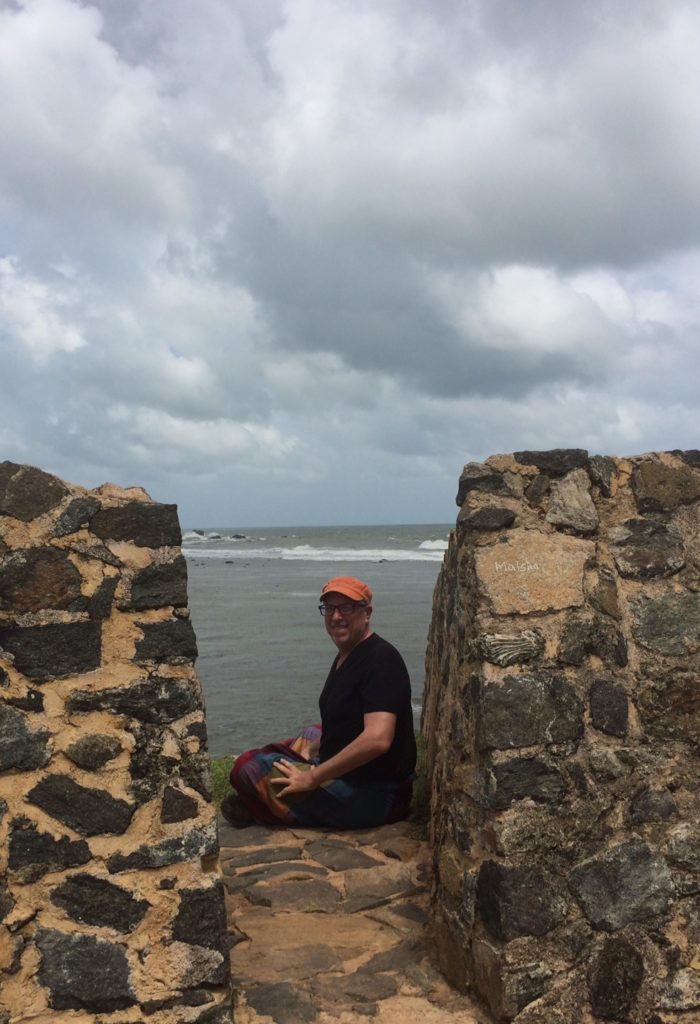
A perfect chill spot to hang out for a while before heading to lunch.
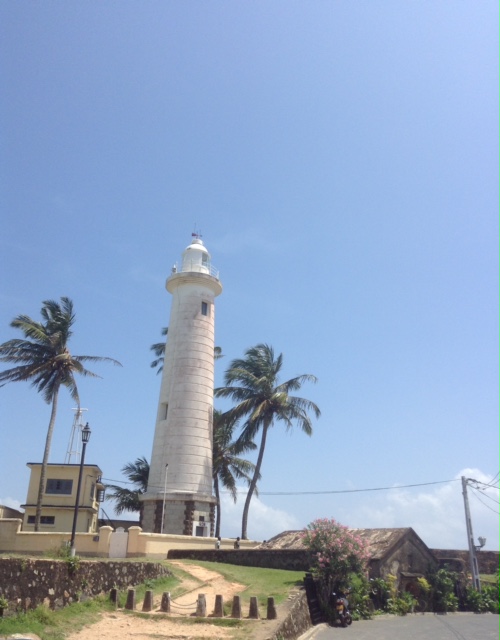
The lighthouse which is at the very tip of the Fort Galle ramparts and has saved many a large ship from crashing onto the rocks.
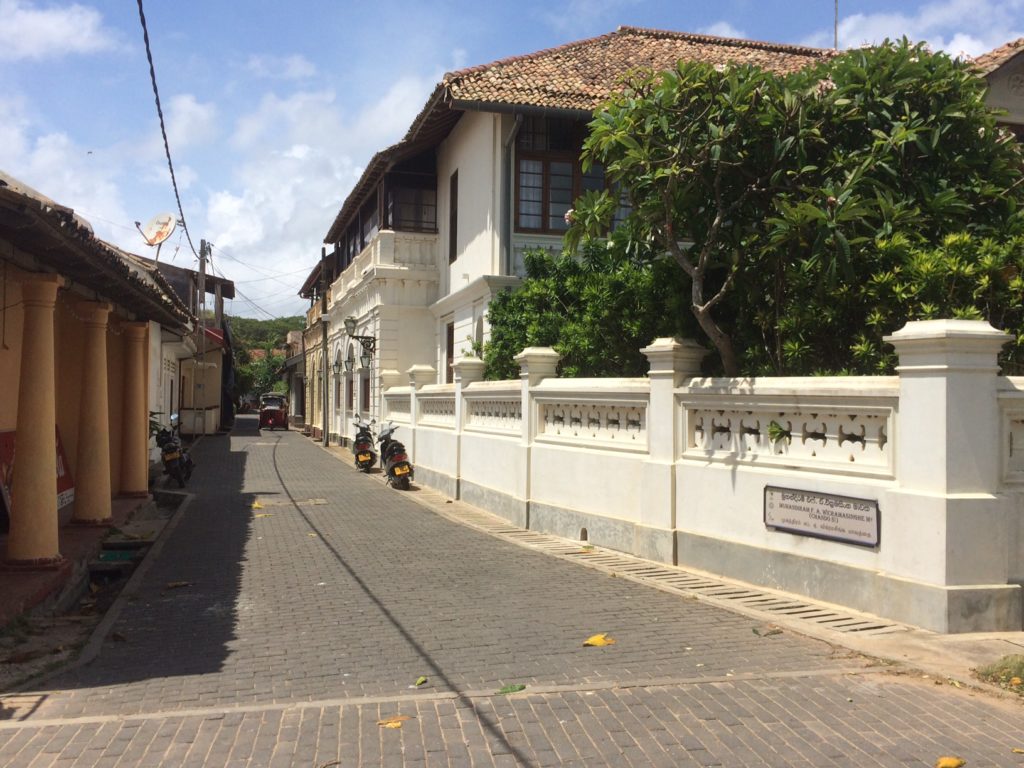
It is very fun to have the city “to ourselves” ~ the streets are mostly empty and we can meander easily.
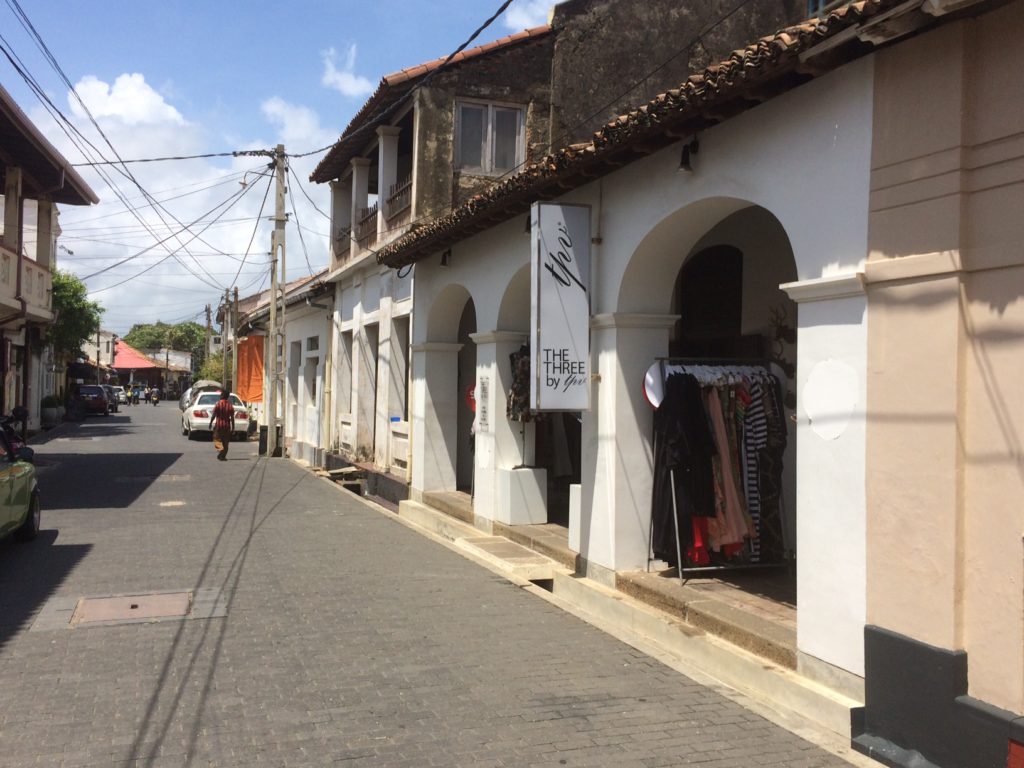
Fort Galle, if one enjoys shopping, is definitely the place to find hand-carved wooden items, hand printed and dyed beautiful fabrics, clothes and in general just to window shop.
The streets of this town are almost literally covered with jewels. The precious and semi-precious gem industry is one of the major contributors to the country’s exports. The appropriately pearl-shaped island is so rich in its mineral diversity that it earned great fame for the quality of gems, as far back as written history recalls.
Marco Polo wrote that the island had the best sapphires, topazes, amethysts, and other gems in the world. Ptolemy, the 2nd century astronomer recorded that beryl and sapphire were the mainstay of Sri Lanka’s gem industry. Records from sailors that visited the island states that they brought back “jewels of Serendib”. Serendib was the ancient name given to the island by Middle Eastern and Persian traders that crossed the Indian Ocean to trade gems from Sri Lanka to the East during the 4th and 5th century.

But while we appreciate the beauty and craftsmanship of Galle’s gem sellers, the true jewels, in our eyes, are the well preserved buildings, large and small, from various historical lineages, that constitute Fort Galle’s unique architecture.
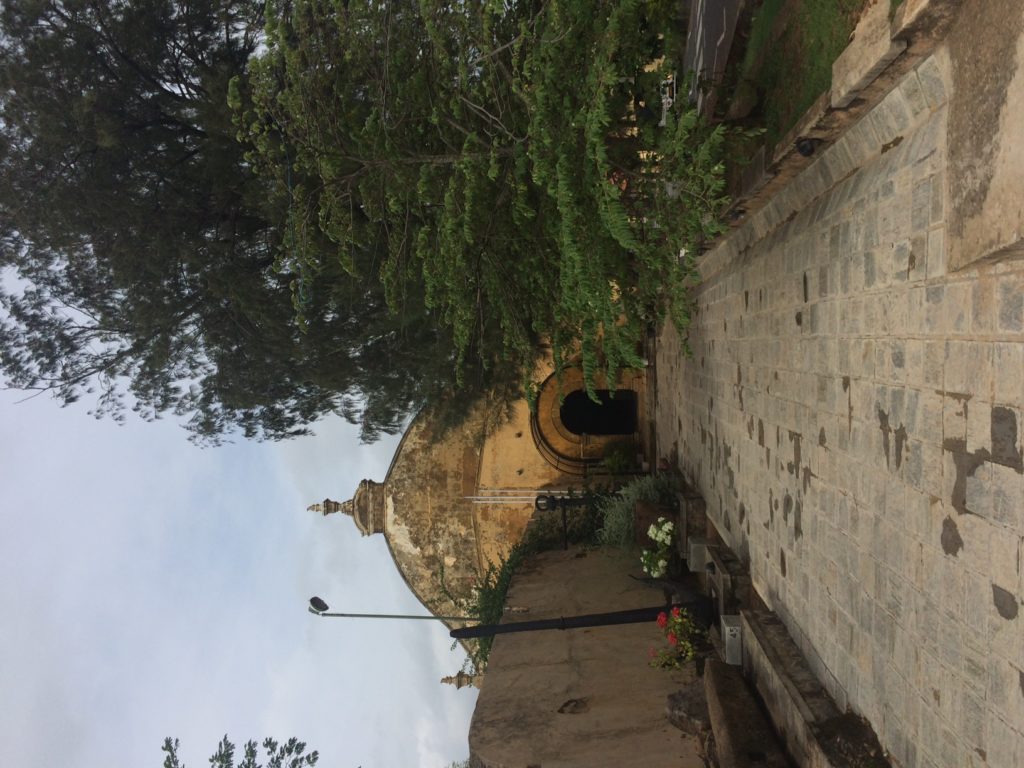
Entrance to the maritime museum shows off Portuguese influenced architecture.
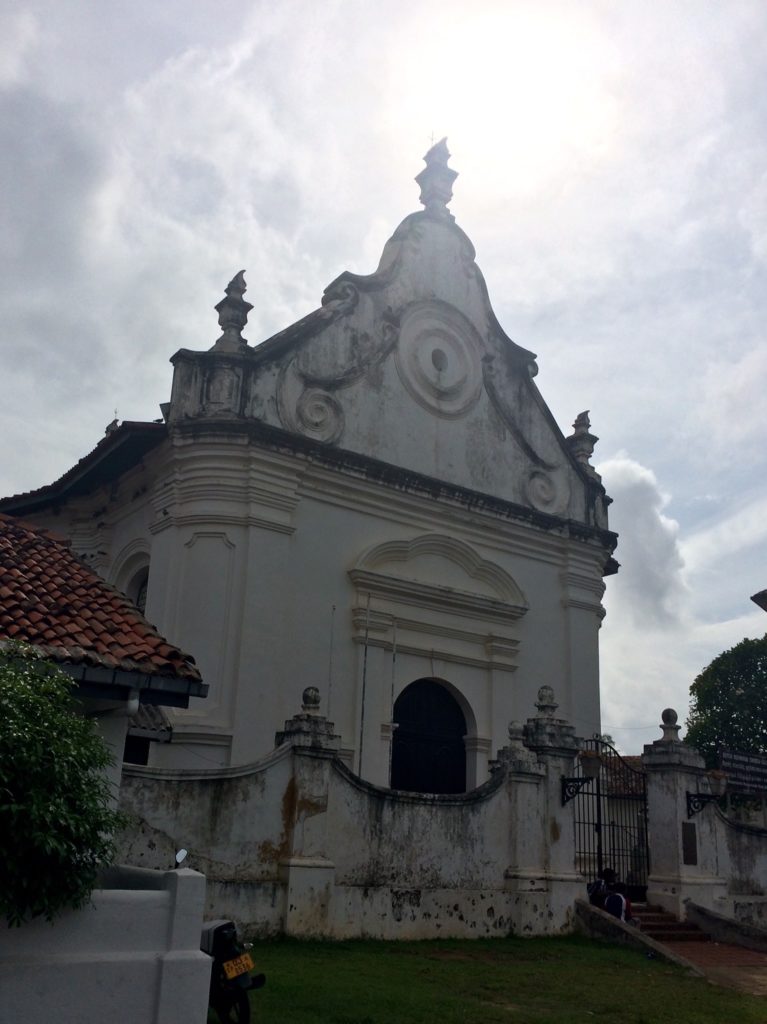
The church has Dutch influenced architecture.
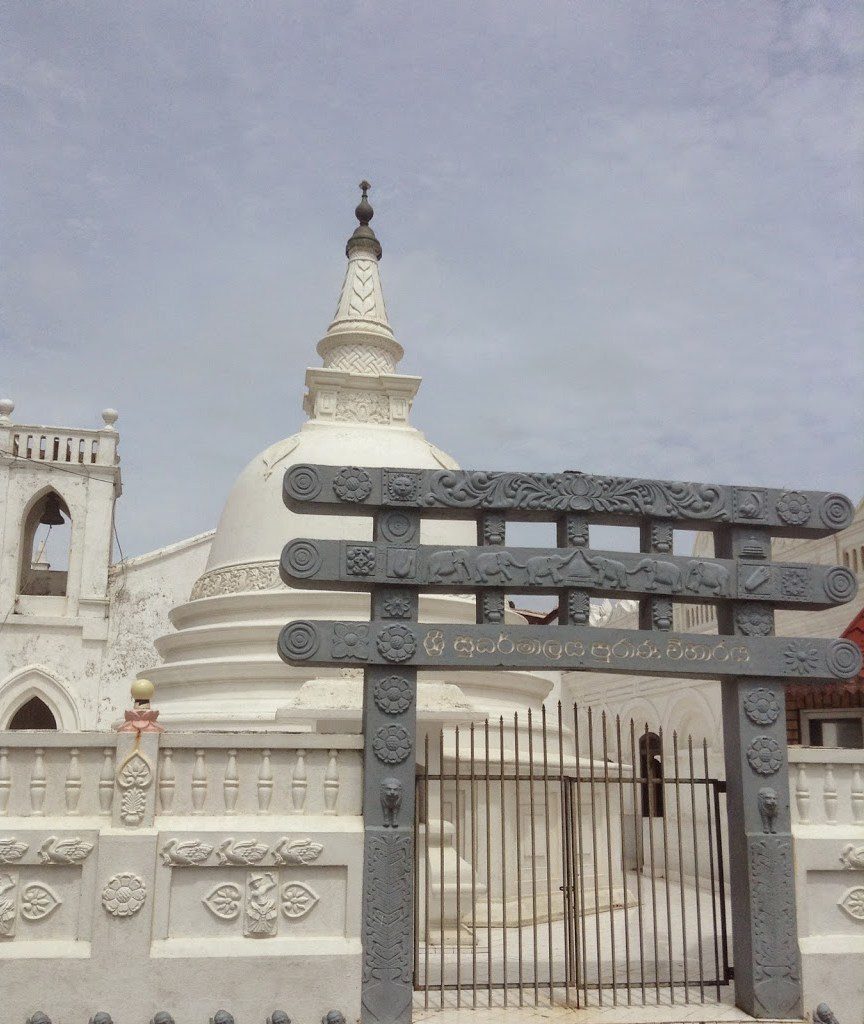
A small white Buddhist temple and stuppa share space with a mosque and a church in this small city.
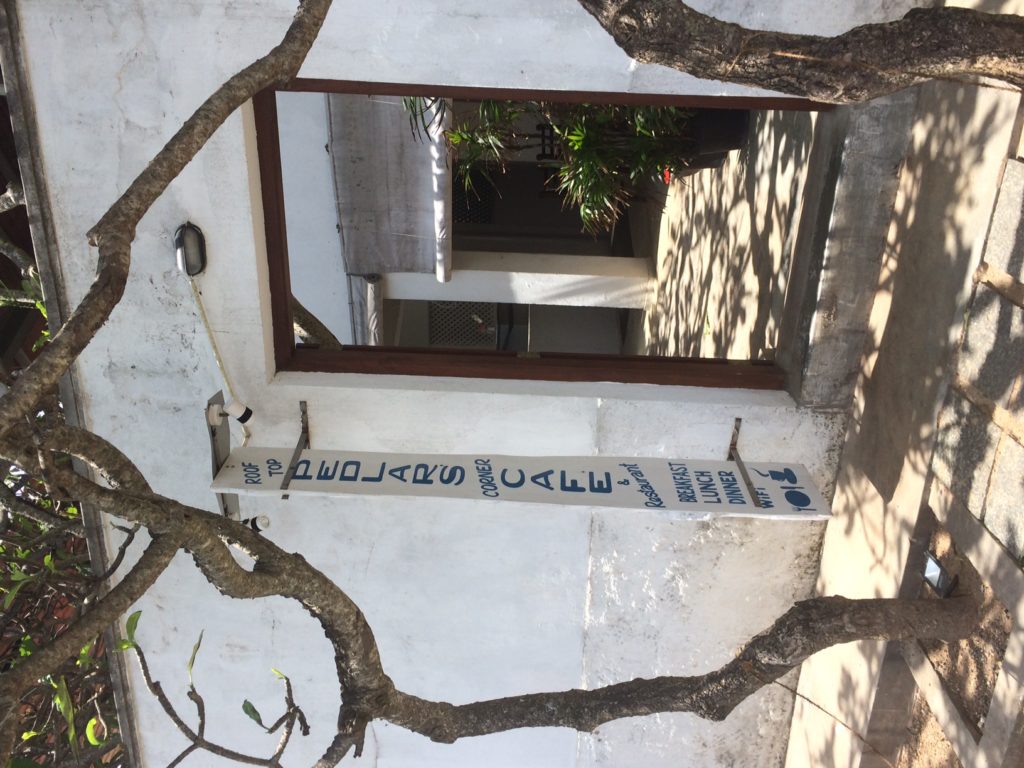
There are a plethora of small restaurants. Many charming, most pretty good, with a few stand out restaurants.
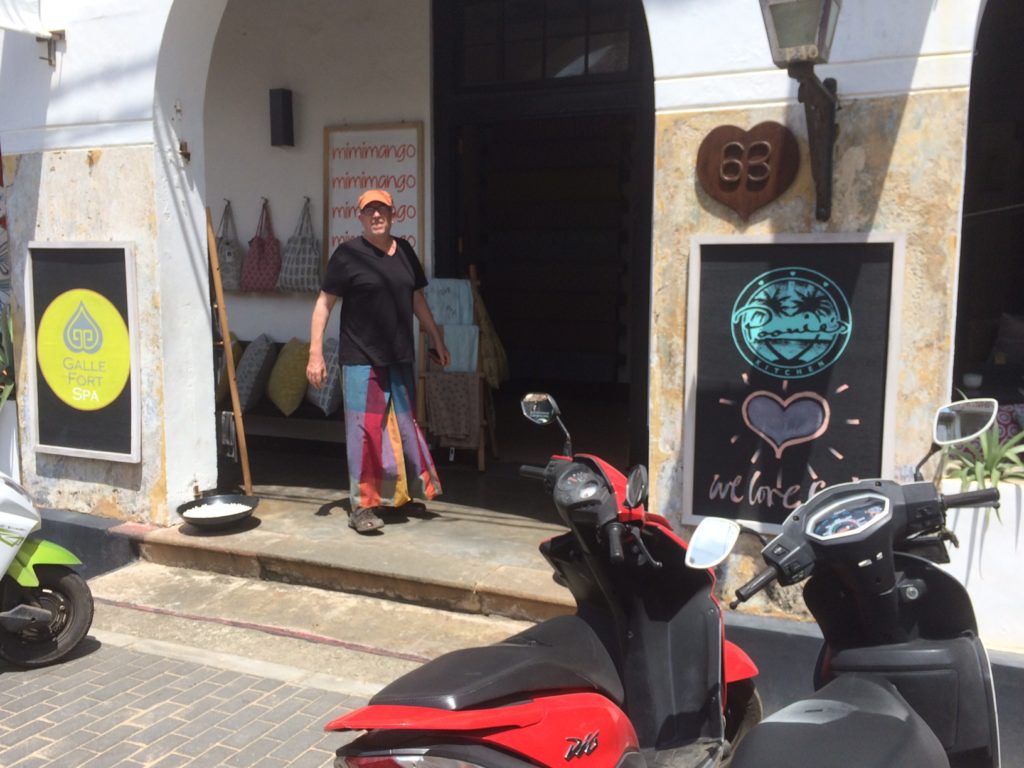
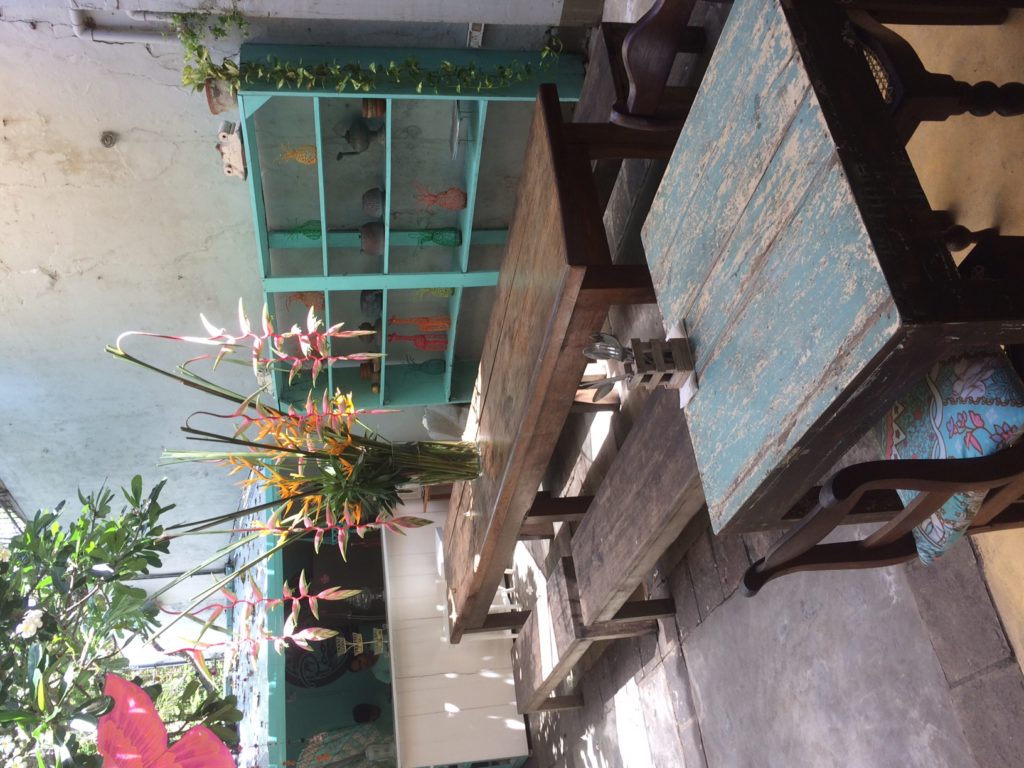
The interior courtyard of one of our “go to” favorite restaurants for lunch in Fort Galle… “Poonies”
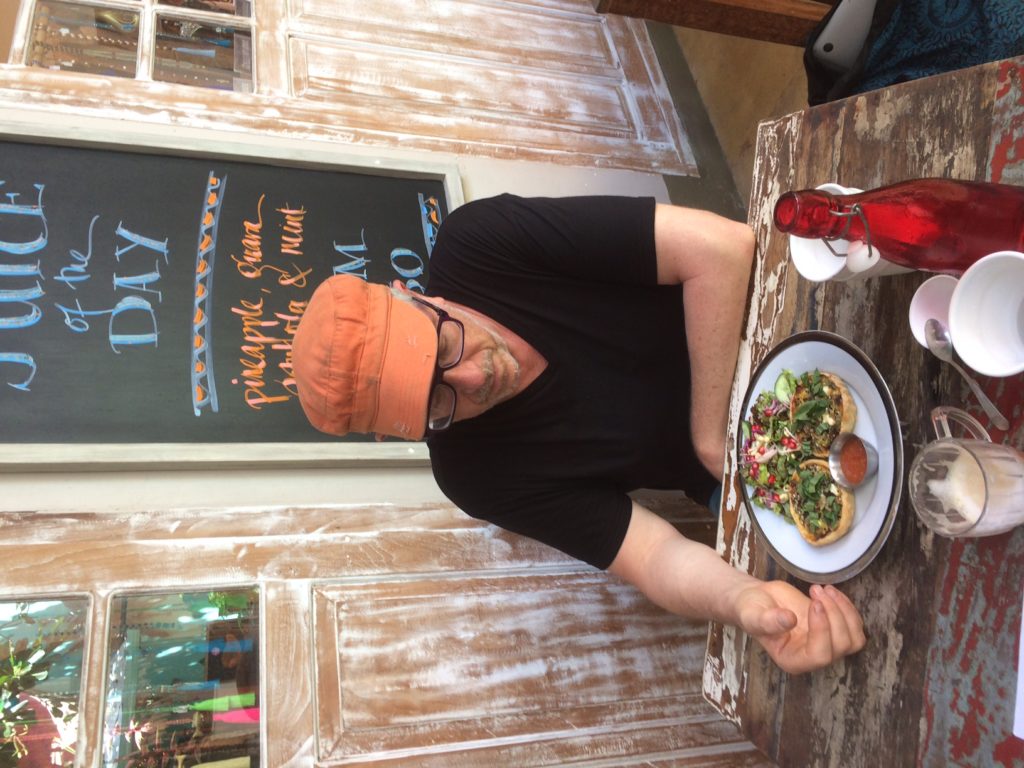
The majority of restaurants in Sri Lanka serve up rice and curry of course ~ this one has some interesting vegetarian options.
If the narrow streets and well preserved buildings of Fort Galle earned the town recognition of the United Nations as a World Heritage Site, it is worth remembering that as a continuously inhabited fortified town since the Portuguese recognized the strategic value of Galle, then through the Dutch colonial period, the town is an absolute treasure trove of antiquities passed on from one generation of Fort Galle residents to the next.
Bringing it all together, one of the oldest mansions of Fort Galle, dating back over 350 years, has become a pseudo-museum, more of a repository of what continuously emerges from Galle’s architectural treasure. It is quaint. It is overflowing with a variety of collections.
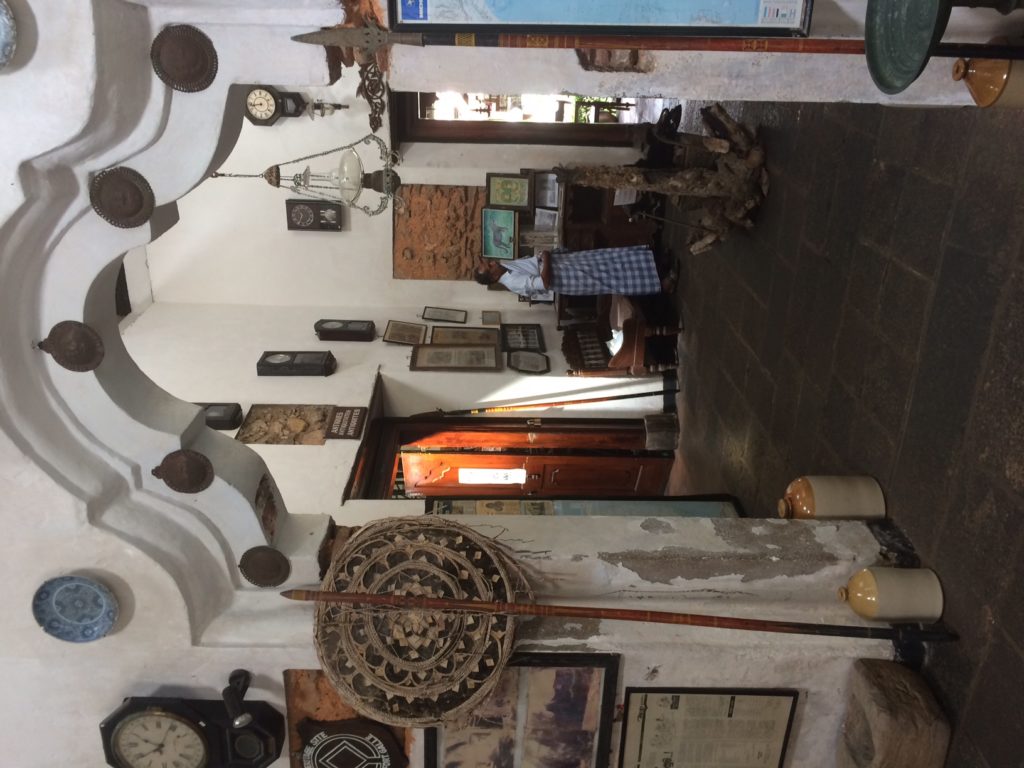
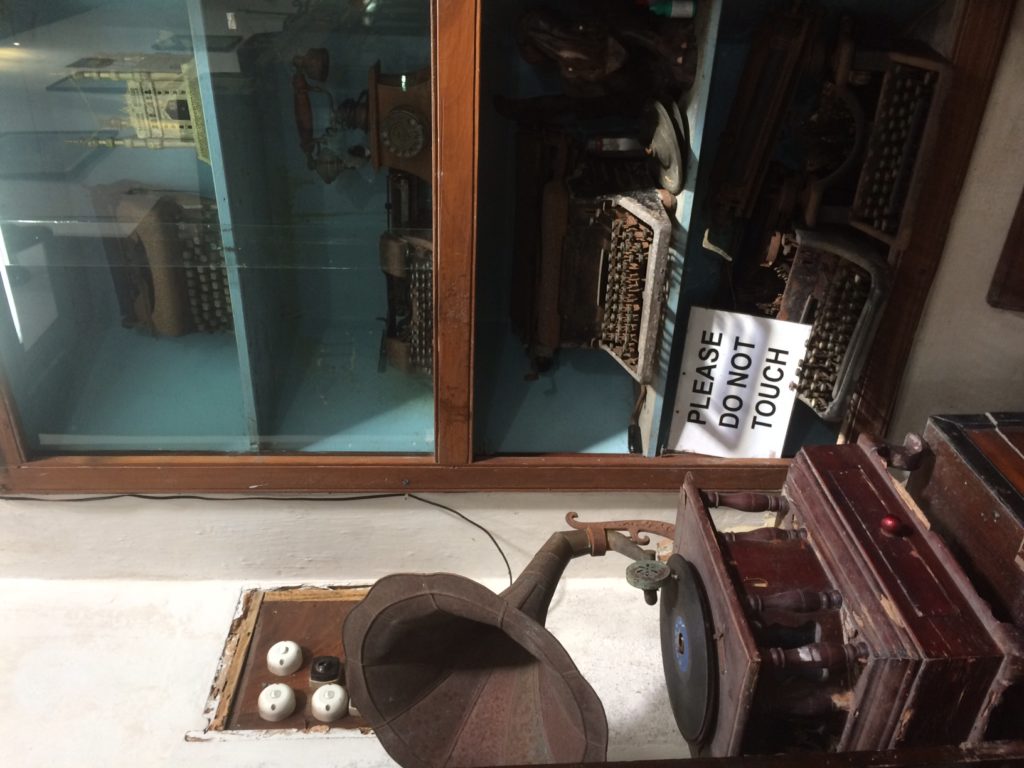
An old gramophone, record players, type writers…
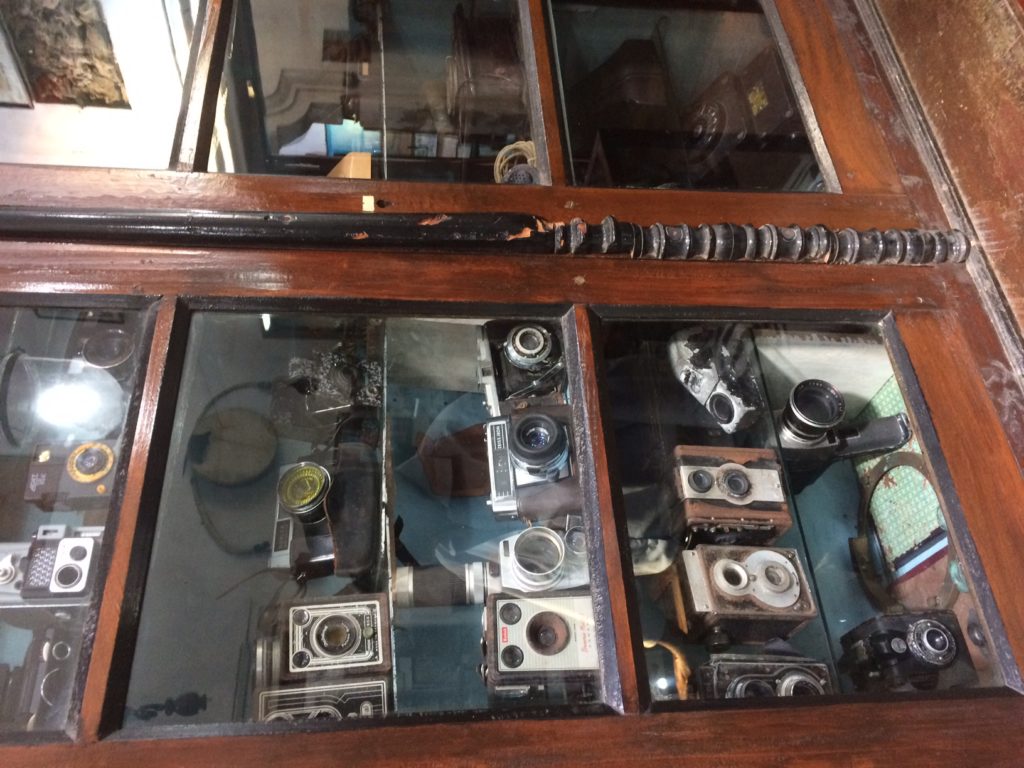
A variety of old cameras. In the days when we people actually bought and loaded film and then took it in to be printed.
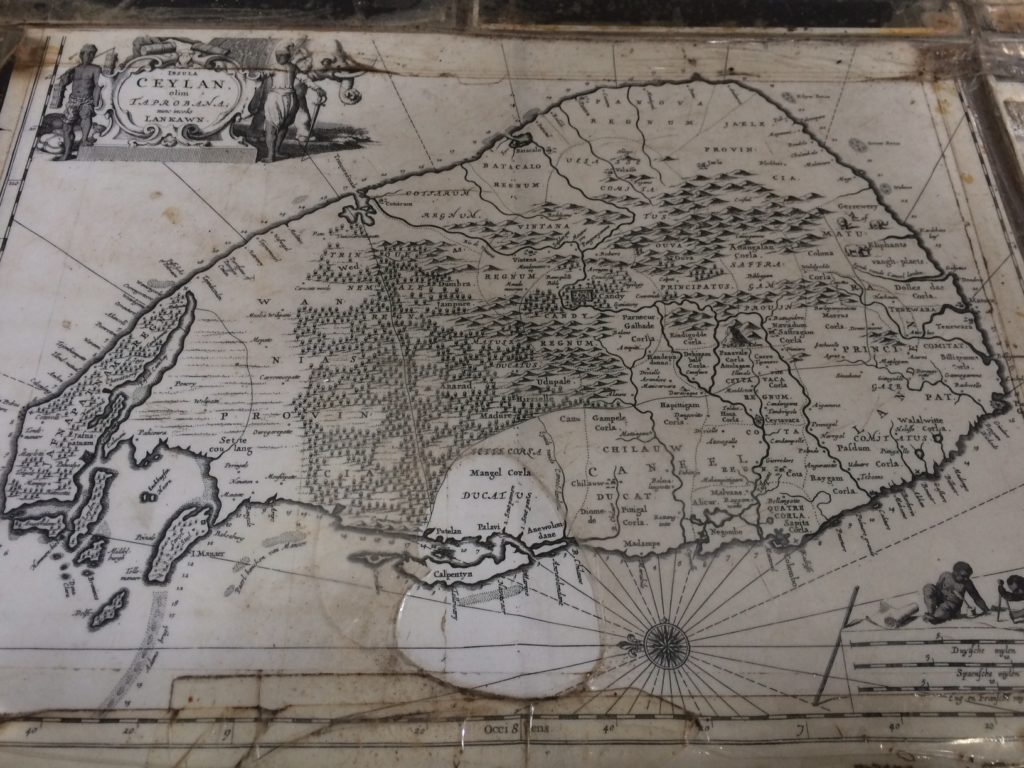
Tabrobane…Serendib… Ceylon… Sri Lanka… The plethora of names speaks to the rich history of our beautiful island. Bizarrely, the authors of this antique map thought it made sense to depict the island horizontally… Traditions are meant to be broken, I suppose.
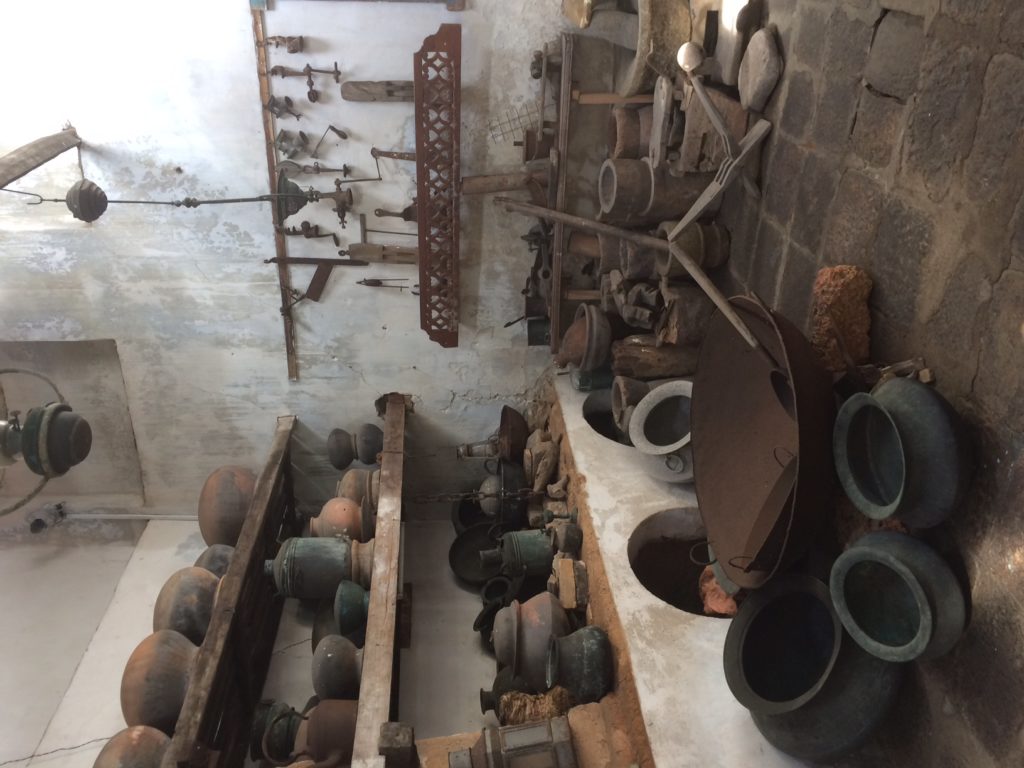
How many Sri Lankan curries must have been prepared in this kitchen…
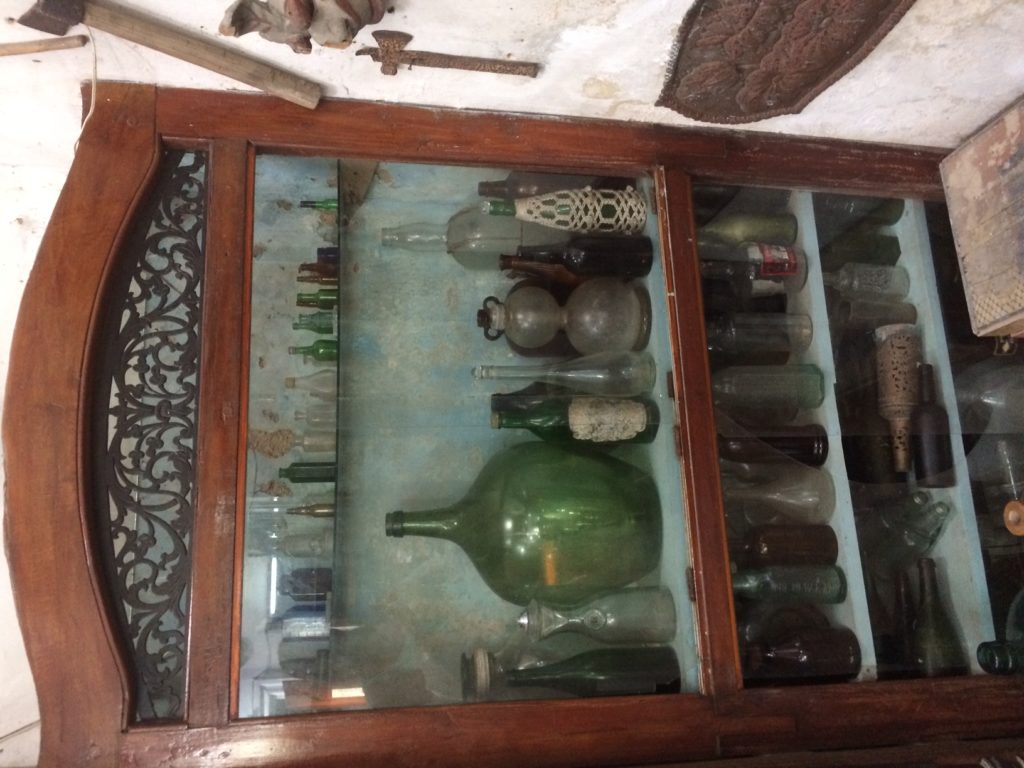
Bottles of all sizes, colors and shapes.
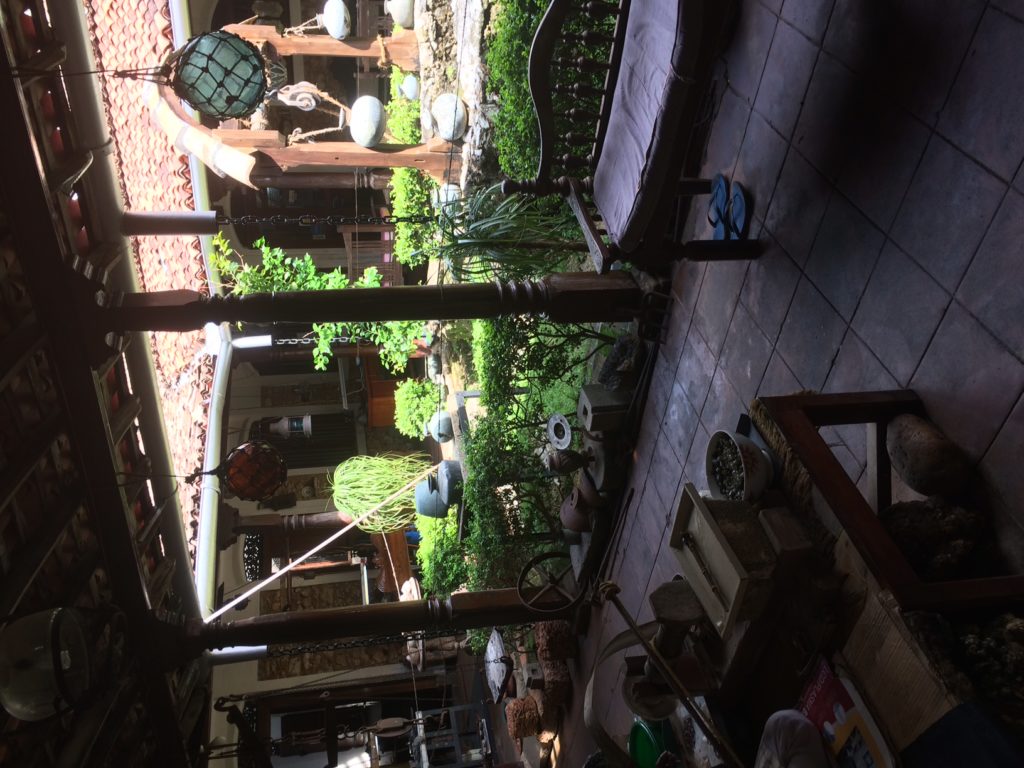
The museum courtyard houses a few artisans demonstrating their skills at a variety of crafts.
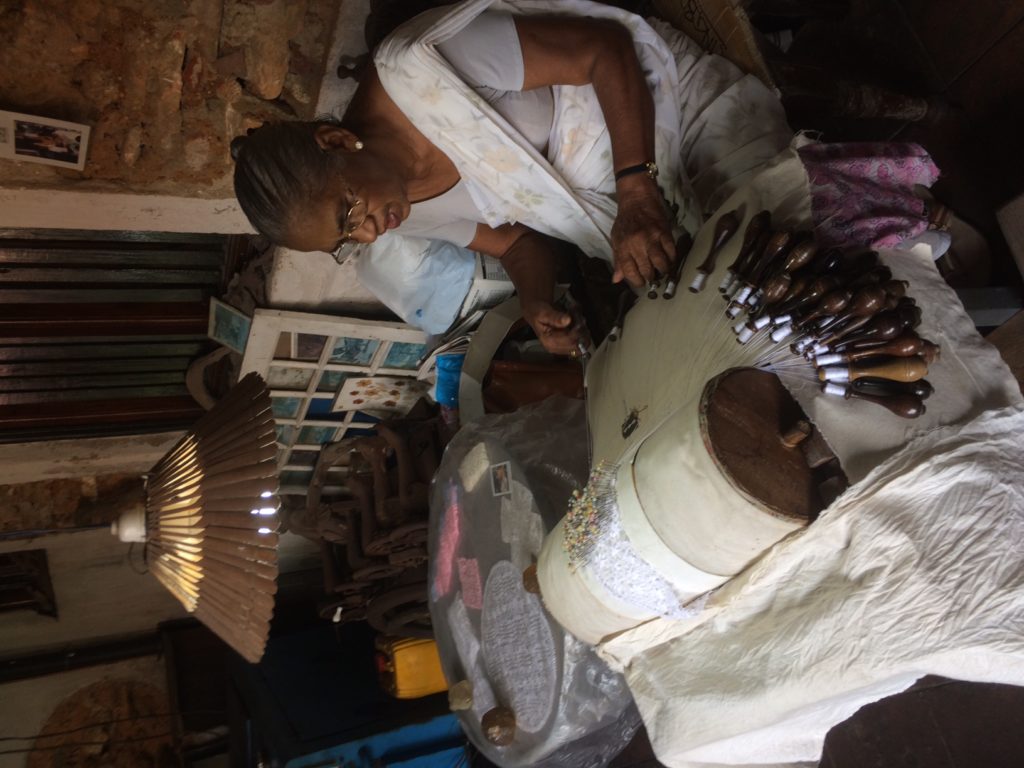
This woman is a lace maker, just like her mother, her grandmother and her great grandmother all were. Why lace? because Holland, at the time of its conquests, was heavily invested in the lace making trade, Nor surprisingly, that trade blossomed under Dutch colonial rule.
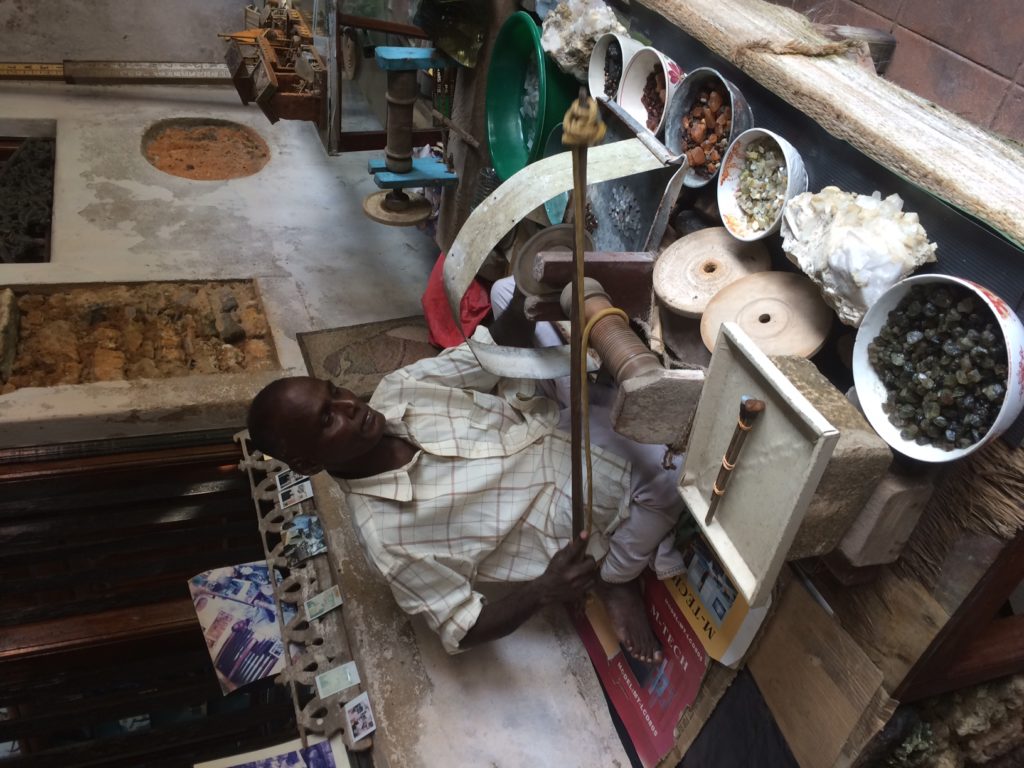
Gem cutting semi precious stones from rock to jewelry is now done primarily by machinery. This man demonstrates how it “used” to be done, the old fashioned way, by hand.
Just like this museum of antiquities, the Southern region of Sri Lanka, with Fort Galle as its most majestic architectural highlight, continues to surprise and delight us when we take the time to explore and enjoy our surroundings.

The lighthouse at night time.
You do live in a unique and interesting part of the world. I love the museum! We continue to find wonderful places here in Spain to enjoy as well. Our visit to Malta in March held some nice surprises too. Thanks for sharing!
Thanks Darlene. This was the first time we noticed this museum as it is on a small side street and very nondescript. We are glad we found it as it had so many interesting different pieces of life in Galle over several generations.
We have never been to Malta but it looks quite lovely, from your posts.
Peta
I can’t find words that express enough superlatives for what I see in your photos, and to say anything becomes redundant. Know that I love every one of your posts and appreciate how much you share with your readers, especially the bits of history. Thank you.
Shari it is so nice to know that you appreciate our photos and our writing. Thanks for the stellar feedback! 🙂
Part of what we both enjoy about traveling and living in countries that are completely new to us, is the steep learning curve, which beings with the history and geography of the place.
Peta & Ben
I love it when you take us exploring with you. You tell a good story with your photos and it feels almost as good as being there. The only thing missing this morning from my end is the sun and warmth 🙂
I love poking around old historical sites like Fort Galle and the wonderful collections they often have on display. I am surprised by the jewel trade though. This was something I didn’t know about. It’s unfortunate that those who are rich in natural resources are often not the ones who get to benefit from it.
Thanks Joanne. Everyone is pretty happy here that the rains and flooding are subsidizing and this visit to Fort Galle was one of the first days without any rain in a while.
The gem industry as the name indicates is quite a complex eco system of lots of people doing lots of different jobs from mining to transportation, to grinding to jewelry design to production. As such, it plays an important role in terms of job creation today as it has for hundreds of years. Of course some of the trade is for the raw material, but Sri Lanka long ago became recognized for its ability to produce not just the gems but as well, the finished jewelry pieces. Fort Galle has about 20 streets and several dozen jewelry stores!
Peta & Ben
Lovely town, thanks for sharing. Your photos are as rich as the scenes you depict. How nicely you embrace the Serendipity!
Glad you enjoyed the photos of Fort Galle! Thanks for stopping by John.
Peta
Peta, your home area looks so enchanting & beautiful. It is not a corner of the world I know much about. Thank you for sharing some of it with us!
Lynn, the interesting thing about the area we now call home is how varied it is within such a relatively compact space. We have the beach which is a five minute motor scooter ride, temples all around (near and far), animal and bird parks within two hours and Fort Galle which is a jewel of a place.
If you interested in reading more of Sri Lanka, you can check out our archives which have posts from the past six months of living here as well as a few visits before that.
Peta
Very interesting town – but I confess the thing that got me most excited was that plate of food in front of Ben! It’s nearly dinner time here – that’s my excuse and I’m sticking to it….
Fort Galle has quite a few good restaurants tucked in between the little boutiques and hotels. We hear ya… we like good food too.
Curry is the national dish of Sri Lanka, but the interesting thing about the curries here is that you can typically have 3 or 4 different types of curry simultaneously in small bowls. Many of these are vegetarian and there are quite a few exotic to us, but mainstay in Sri Lanka, veggies that get used. As addictive as curries get, it is nice to have variety!
Peta
It looks lovely! Just the kind of place I’d enjoy exploring.
Alison
ALison it is definitely a fun place to explore except for the fact that it is the single most popular destination for tourists coming to Sri Lanka and it is often teeming with visitors. We really are enjoying this hiatus right now when the full beauty of the town reveals itself.
Peta
Great pictures, as always. I enjoy reading your travelogs, or virtual tours, as they’ve become. Glad to hear the weather improved. How did your little house do in all the rain?
Sharon thanks for the compliment on the “virtual tours”!
Our house did just fine, thanks to the new roof we put on just weeks before the heavy rains began. In fact it started raining about an hour after the roof was done. So nice to be dry inside the house! Quite the novelty….
Peta
Wow, amazing to see what life is like in this part of the world.. surprised to see veggie restaurants with signs in English. Nice architecture too. Thanks for sharing!
Nice to know you are reading us Ez…
Sri Lanka was a British Colony until 1948 so there is a significant slice of the population that speaks English. As well, in most of the touristy type places, such as this (which is a Unesco World Heritage Site), signs are in English and those in the tourist industry (restaurants, hotels etc) speak English.
Glad to read you appreciate the photos of the architecture. Definitely a place made for strolling and enjoying the remnants of Dutch and Portuguese architecture.
B&P
Love your pictures and commentary. Thanks for sharing with us. I would be in awe looking at all those gem stones. Like to see what many look like “raw” … I do readings with a deck of cards called “Jewels of the Lotus” which subscribes different healing qualities to stones/crystals and Buddhist philosphy.
Gail the gem stones definitely provide an unusual element to the small stores in Fort Galle. Fort Galle is the visible last phase of the gem trade. When we took a trip a while back to the hilly town of Ella, there were people selling large buckets of raw stones such as rose quartz, white quartz, on the side of the road. A big chunk of quartz was about $1.50!
Your cards sound interesting. Are they tarot cards? I have definitely read up about some of the different healing properties of different semi precious stones. I wonder how Buddhism and crystals correlate….? Interesting.
Do any of your cards happen to have a “moon stone”? That is a stone that is supposedly unique to Sri Lanka.
Peta
Thank you so very much for this wonderful trip to Galle. I haven’t been there since the 1980s. Time for a revisit.
This is the fantastic thing about 500 year old towns… they don’t change that much, especially if protected by Unesco. It would be interesting to know if it has changed much. We will have to wait until your revisit, to hear!
B&P
h e a v e n l y.
Thank you so much for allowing us to experience this paradise, too! xx
So glad you enjoyed this post so much!
Peta
Nice to see that you are both there and enjoying your new hometown for a bit. It must be so fun to explore a new place, learn so much new history, AND feel like you are a bona fide part of it. I’m glad that your choice is working out so well. Are you pleased with the way the house turned out and is it totally done now?
Lex, the steep learning curve about the history, the geography, culture and people is very much a part of the attraction for us. Living in a place obviously gives one a deeper insight into all of these elements.
The house is coming along nicely… Definitely still a work in progress as there are many things we would still like to do to make it really comfy. We will need to do an update post at some point. The absolute highlight of the house, strange as it sounds, is the garden bathroom which is now akin to a jungle. We both love taking showers surrounded by greenery, birds, monkeys, clouds, the moon.. It is the best bathroom EVER! Super cool.
B&P
I don’t think that sounds strange at all – that bathroom was INSPIRED from the beginning!
Thanks Lex! It is so nice to see something that we envisioned a while back while in Indonesia, come to life. And actually it is even better!
Peta
Fabulous pictures and the narrative that goes with them. THANK YOU for taking the time to document your explorations.
Thank you Judith for the compliments and lovely feedback.
B&P
Wonderful to read another of your posts with the beautiful pictures! I love tripping around with you, really get a great feel for a place!
Loved the look of that meal, Ben!
Sri Lanka looks to hold so much charm and gentleness…
Thanks for all your sharing!
Stan, so nice to know you are reading us and enjoying “tripping” with us… So when are you coming for a visit? We are not that far from Israel!
We are quite the experts at finding all the good veggie offerings in restaurants.
I like that… “charm and gentleness”… Indeed.
xoxo
P
Visiting a place like this in the low season must have been great? To have it all to yourself…magical. You live in such a beautiful area full of fascinating history, architecture and culture. I love reading your blog posts?
Thanks Gilda ~ and we love reading readers comments, as it give us a sense that we are sharing our experience and lifestyle with others all over the world.
Yes I think we chose our location rather well, after two years of research in SE Asia. Our problem was that so many countries we lived in sequentially had equally beautiful and culturally rich environments. But eventually we narrowed it down to 3 and Southern Sri Lanka “won this round”!
Ben
Fort Galle is so “western”, I can relate to it!!!! I love all your descriptions and beautiful pictures. Thank you Peta/ Ben
Madame Bell, so glad that you are still reading us and enjoyed this blog post. By Western, you mean the Dutch and Portuguese influences on Fort Galle no doubt. Born and raised in Europe, you always seem to resonate more with European influences than Asian ones… There is no question that you would appreciate the beauty of Fort Galle, the luxury of the hotels there, and it is just ten minutes from where we live!!
Bisous xoxo
Ton fils et Peta
As with each of your posts, I’m sitting here in lush green New England-with the rain and mist-drooling over your photos of your new home country. The sun and entire area look so enticing, although I understand that you’ve also had a lot of rain.
Your photographs are spectacular and make me feel as if I was right there.
Where do most of the tourists come from? I’m really curious if you get many Americans there. If this country was not quite such a long flight away – I would love to come visit and enjoy its many charms. Namaste
Thanks Pamela, especially for the lovely comments on the photographs! ~ it is so nice to think of you reading us in New England. Yes, May was one of two monsoon seasons here in Sri Lanka. There was severe flooding with tragic consequences for many. But thankfully the rains seem to have subsided now.
Most of the tourists here are British, Dutch, French, Australian, Russian and Chinese. Very few Americans. It is not that long a flight if you consider it as two flights to Europe one after the other and the fact that it is worth the distance. Sometimes what we do is we break the trip to or from the U.S. by stopping in Europe (Paris, Amsterdam, London, Turkey are good choices…)
Peta & Ben
Enjoyed the photo-tour along with the local flavors – thanks much!
You welcome Dahlia, thanks for stopping by to read us!
Peta
This looks like an interesting retreat. I particularly enjoyed the gate into Ft Galle, along with the view through the rampart. Your photos created a distinct transition (inside vs. outside) that feels surprisingly comforting yet mysterious (I wonder what it’s going to be like on the other side).
Gabe, you are right, the gate to the old fortress city is full of character and one definitely gets a feeling of a grand entrance from the outside to the interior of Fort Galle. The town of Fort Galle is surprisingly large for a fortified town.
The old town of Galle is the best example of a fortified city built by Europeans in South and South East Asia showing the interaction between European architectural styles and South Asian traditions. Also, because the town has a very strong Muslim population, it is not just the gate that informs you that you have arrived, it is also the frequent call to prayer that eminates from the mosques.
Peta & Ben
Our favorite part are the ramparts looking out to sea.
What a fascinating place. I could spend days wandering through the streets and into the little shops. Love all the vintage cameras. And the FOOD! It seems like one of those places that unveils a new facet every time you visit. High season does not sound fun, however.
JD you are absolutely right, every time we visit we take a different side street and peel another layer, finding some new “treasures” be they architectural, or a new little restaurant or freshly restored Dutch Colonial house.
Peta
The Portuguese influence is definitely visible. I was thinking that with those hefty walls the town obviously had something to protect and then you showed me the gems. 🙂 🙂
Ha ha Johanna that’s funny. Actually the walls of Fort Galle played a critical role in the 2007 tsunami (which ripped through Sri Lanka and created massive destruction and many casualties). The fort walls completely protected the historic city so much so that the inhabitants were unaware of the destruction going on right outside their walls in the rest of the city.
The ramparts are a brilliant piece of Portuguese architecture. We saw and enjoyed a similar fort with thick ramparts in a city South of Essaouira, Morocco.
Ben
Interesting place – looks like it’s worth a visit. I suppose discovering all those interesting facts about the location might be considered “Serendibity”.
Absolutely worth a visit if not a few repeated ones…. There is much to discover and enjoy in this part of Sri Lanka. The first time we visited it as travelers and Ben declared “one day we will live here.” So we don’t live within the fort, but we do live nearby. Serendipity indeed!
Peta
How different Galle is from the other cities you’ve written about and I can definitely see why it would impress even the most “blase” of visitors. I was looking at the fort and thinking it reminded me of the fort in Essaouira, Morocco and saw, in one of the comments, that you’d also noted that similarity.
It’s unbelievable how thick the walls are and easy to see the part they would play in protecting the city from invaders and even the most devastating of storms. It’s also interesting to see the Portuguese and Dutch architectural influences.
Galle definitely deserves its UNESCO designation and I so enjoyed your introduction and photos of the fascinating city!
Ah yes, Essaouira, another one of our favorite towns in the world…
The residents of Fort Galle are proud of both their physical and social infrastructure. The physical ramparts did much to protect the town. But it was the ability of the communities of the three faiths of Fort Galle – Muslims, Buddhists and Christians – to join forces and help each other in a time of need, after the tsunami of 2007, that added to the resiliency of the town.
While it may be impossible to build 1 meter thick ramparts around all sea-side communities today (but plenty of other climate adaptation solutions are available), the role model of cooperating communities of different faiths is a very much a role model for municipal resilience that the world could very much learn from.
There is no UN denomination for such social achievement, but it is nonetheless a hard asset of Fort Galle worth acknowledging.
Ben
I could sit on those ramparts forever, staring out over the sea! The architecture looks stunning and the lighthouse is cute and picturesque. I so enjoy looking at (and taking photos of) pretty lighthouses. And coastlines… And… 🙂
Such a diverse country, especially when realizing the different names in the past and the different religions happily existing side by side. You guys had a fun-filled and action-packed day!!
Ramparts are one of our favorite architectural features of fortified towns and we have come across quite a few along our travels. The one at Fort Galle is definitely memorable.
We are glad it comes through in our posts just how very diverse this tropical island is! Fort Galle is the prime architectural highlights of Sri Lanka, in our opinion of what we have seen so far.
Peta
The European influence, esp. Spanish, looks visible and remarkable. Even on the emblems and carvings! And quaint sure is a good description of the place. I love the coastal view and the first photo after the line ” It is overflowing with a variety of collections.” Very nice post, very full and interesting.
Thanks Rommel. Glad you enjoyed this post. The European influence on the architecture is predominantly Dutch and long before that, Portuguese. It was the Portuguese that built the large fortress walls that have protected the city for hundreds of years now.
Ben
I can see why you wouldn’t mind visiting this place often. Your favourite view from the rampart is indeed special. How long does low season extend (or is it different for various parts of the country)?
Caroline the low season is pretty much all of May and early June, and again in September and this was true as well in Nicaragua.
Interestingly though in Sri Lanka, Arugam Bay on the East Coast is a surfers paradise and May, early June are the busiest season as this is when the waves are the best.
Thanks for stopping by to read us.
Peta
Thanks. I’m taking it all in…one of these days, we’ll get there!